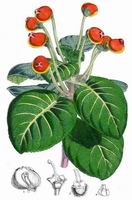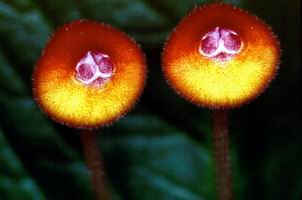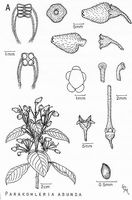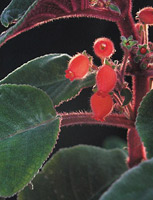

Left: Bot. Mag., t. 5655 (1867)
Right: Phot. W. Barthlott
Full name and orig. publicationPearcea Regel, Gartenflora 16: 388 (Dec. 1867).
Etymology: Named in honor of Richard William Pearce (~1835-1868), who collected plants in South America for the horticultural firm Veitch & Sons.
Synonyms: Parakohleria Wiehler (1978).
Infrafamilial position: Gesnerioid Gesneriaceae (Gesnerioideae) - Gloxinieae.
Description: Terrestrial, perennial herbs, usually with conspicuous indumentum, occasionally with stolons, rarely with scaly rhizomes. Stem erect. Leaves decussate, those of a pair (sub)equal, petiolate, lamina usually (ovate-)lanceolate, often pilose or hirsute. Cymes congested, pedunculate (rarely without peduncle), emerging from the axils of frondose leaves. Sepals 5, basally connate. Corolla bent downward at base, narrowly to broadly funnelform, subventricose or ventricose, more rarely urceolate, throat often constricted and limb usually subregular, rarely bilabiate, usually villous or pilose outside; red, often basally and ventrally yellow, rarely entirely yellow. Stamens 4, didynamous, usually included; filaments coiling in the female stage to pull anthers deeper into the corolla, anthers cohering apically and laterally; staminode usually present. Nectary usually of 5 free glands, two sometimes connate. Ovary semi-inferior; style and stigma usually included, the latter stomatomorphic or slightly bilobed. Fruit a fleshy, bivalved capsule with loculicidal dehiscence. Seeds very numerous, irregularly striate, brown or black.
Chromosome number: 2n = 22.
Species number: 17.
Species names (incl. publication and synonyms): See Skog, L.E. & J.K. Boggan. 2005: World checklist of Gesneriaceae: http://persoon.si.edu/Gesneriaceae/Checklist.
Type species: Pearcea hypocyrtiflora (Hook.f.) Regel
Distribution: Eastern Andean slopes and adjacent lowlands from N Colombia through Ecuador and Peru to NW Bolivia, P. sprucei has the widest distribution, occurring nearly in the total range of the genus, including the western Andean slopes in Ecuador. All other spp. are much more local, 13 spp. being endemic to a single country. Centres of diversity are the N and C Ecuadorian Amazon region and C Peru.
Ecology: Occurring in lowland rainforest (below 700m) to cloud forest above 2500 m, particularly rich in species and individuals are the lower montane forests.
Notes: Pearcea was originally described as a monotypic genus, a second species was later added by Mansfeld (1936). The revision of Kvist & Skog (1996), however, led to an expansion to 17 spp. by the inclusion of Parakohleria, species of Kohleria and the description of new species. Conspicuous is the range of flower shapes which includes also strongly ventricose and urceolate forms. The usually red or red-yellow coloration suggests pollination by hummingbirds.
Selected references: Wiehler, Selbyana 6: 175 (1983); Kvist & Skog, Smiths. Contr. Bot. 84: 1-47 (1996), emend. & rev.
Bibliography: See Skog, L.E. & J.K. Boggan. 2005. Bibliography of the Gesneriaceae. 2nd edition: http://persoon.si.edu/Gesneriaceae/Bibliography.
Illustrations:
 |

|
Pearcea hypocyrtiflora (Hook.f.) Regel, type species
Left: Bot. Mag., t. 5655 (1867) |
 |
 |
Pearcea abunda (Wiehler) L.P.Kvist & L.E.Skog
Left: Selbyana 5: 7, fig. 1A (1978), as Parakohleria abunda
Wiehler
|
last modified: 2007-01-08